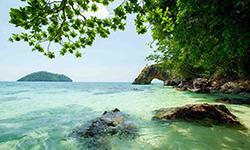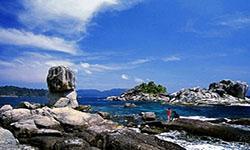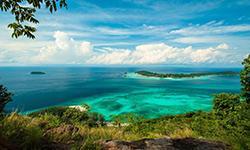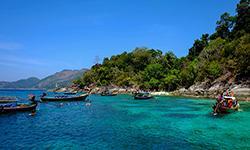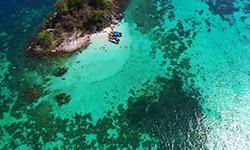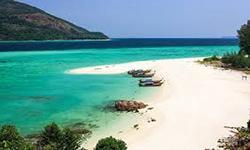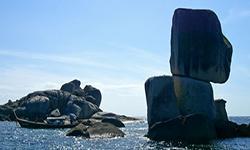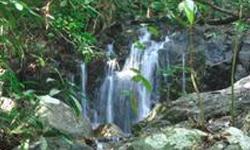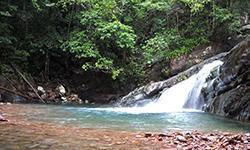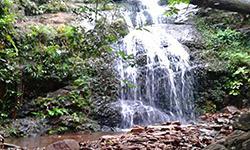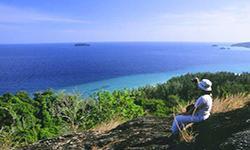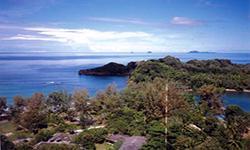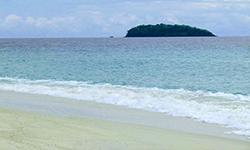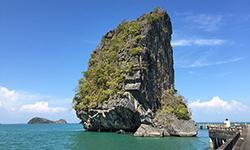Tarutao National Park
Contact Location : Tarutao National Park, Pak Nam Sub-district, La-Ngu District, Satun Province, Postal Code 91110
Telephone Number : (+66) 7 478 3597, (+66) 7 478 3485
Email : tarutaosatun.go@hotmail.com
Facebook : Tarutao National Park
Information
-
Background
The Legend of the Mu Ko Thale Tai
"Tarutao" is a distorted word from the Malay word "Talo Trao", which means a lot of bays. Ko Tarutao is a national park in the Andaman Sea in the Malacca Strait area of the Indian Ocean. It is near the land of Mueang District, Satun Province, which is in the south of the National Park. It is only 4.8 kilometers from the Thai-Malaysian border. Tarutao National Park is a dreamy tourist destination that has natural beauty, both on the islands and in the water. It is inhabited by a wide variety of wild animals and the water is beautiful with colorful corals. The 51 large and small islands cover an area of approximately 931,250 rai, or 1,490 square kilometers. "
In 1936 A.D., the Department of Corrections wanted a location with suitable terrain to detain criminals. They chose Ko Tarutao and when on July 13, 1937, the under the leadership of Khun Phithan Thanthathai, explored Ko Tarutao in the areas of Ao Talo Udang and Ao Talo Wao in order to establish a "penal institution." After overcoming various natural obstacles for 11 months, the survey ended.
In June 1938, Ko Tarutao became a prison and vocational training camp for criminal inmates. Consequently, a royal decree established restricted land for the benefit of correction, which was published in the Government Gazette, Volume 56, Page 566, May 29, 1939. At the end of 1939, the government sent political prisoners from the Boworadet Rebellion (1933) and the Sergeant Rebellion (1935) which meant a total of 70 people on Ko Tarutao detained at Ao Talo Udang.
During World War 2 (1941 - 1945), Ko Tarutao was effectively cut off from the mainland, and there was a chronic a shortage of food, medicine, and supplies. In early 1944, prison guards acted as pirates to pillage Thai and foreign cargo ships that sailed back and forth in order to survive. Thai government and British soldiers successfully defeated these “Tarutao pirates” in 1946 and, two years later, the Department of Corrections cancelled the Tarutao Vocational Training Estate.
In 1972, the Royal Forest Department, Ministry of Agriculture and Cooperatives, designated the land area of Ko Tarutao, Ko Adang, Ko Rawi, and other nearby islands as a national park. This was passed by the Revolutionary Council of the time on October 19, 1972. As such in March 1973, Mr. Tem Smitinan, a specialist in forest botany, Mr. Pairote Suwanakorn, National Park Division Superintendent, and assistants traveled to explore Ko Tarutao, Ko Adang-Rawi, and the archipelago nearby. They found that the islands were beautiful and rich in natural resources with interesting natural conditions. suitable for establishing a marine national park.
The National Park Board resolved in meeting 1/2516, on August 1, 1973, to establish Ko Tarutao as a national park. the National Park Division of the Royal Forest Department issued order 960/2516, dated September 11, 1973. Mr. Boonruang Saisorn, a forestry scientist, and Mr. Pricha Rattanaporn, a forestry scientist, established the island as a national park. The Royal Forest Department has then made a request to withdraw the area from being protected for the Department of Corrections, to be designated as a national park. A royal decree specified the land of Ko Tarutao, Ko Adang, Ko Rawi, and other islands in Ko Sarai Sub-district, Mueang District, Satun Province, which covered a total area of approximately 931,250 rai, or 1,490 square kilometers,Tarutao National Park became Thailand’s 8th National Park when details were published in the Government Gazette, Volume 91, Part 68, dated April 19, 1974.
Tarutao National Park was designated as an ASEAN Heritage Park on November 27, 1984, which means it is an area of high importance and the the ecosystem of the region should be conserved.
Note : After paying the entrance fee to the National Park, please carry the receipt for inspection.
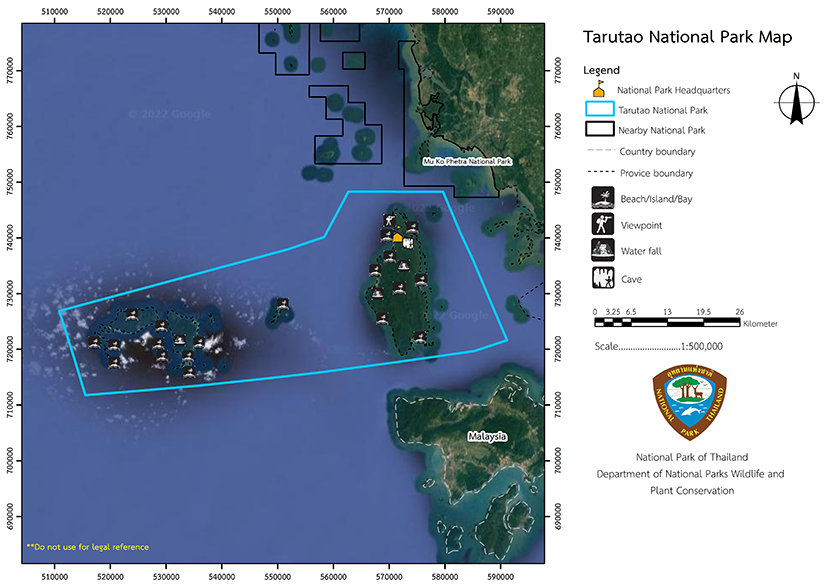
931,250 rai (1,490 square kilometers)
|
|
|
|
|
|
|
|
|
|
|
|
|
|
|
|
|
|
|
|
|
|
|
|
Nature trails ⇔ Trekking ⇔ Visit Waterfall ⇔ Swimmimg ⇔ Cave exploration/Geological condition ⇔ History and culture watching ⇔ Observe flowers/plant ⇔ Bird , butterfly , wildlife watching activities ⇔ Mountain biking ⇔ Take a boat ride or a paddle ⇔ snorkeling ⇔ Scuba diving ⇔Take a photo/Video ⇔ Camping ⇔ Relax in a nature
Welfare shop :
Welfare shop (coffee, drinking water, snacks)
It is open daily from 7.00 – 16.30 hrs.
The restaurant is open daily from 7.00 – 14.00 hrs. and 17.00 – 21.00 hrs.
Tarutao National Park area: AIS, TRUE, DTAC
There is an electrical system and lighting from a generator (electric generator)
Electrical system: open from 18.00 - 6:00 hrs.
on both Ko Tarutao and Ko Adang
|
|
The terrain is that of high mountains that cover most of the island. The highest peak is 703 meters above sea level and the islands are surrounded by towering karsts. There is a specific plain above the beaches. Ko Rawi has an area of 28.44 square kilometers and a complex mountain range. The average height of the island is 460 meters above sea level, and there are steep slopes to the low plains. The soil properties in Tarutao National Park can be classified as: (1) In the area of Ko Tarutao, the soil properties are Rayong series soil, Rue So soil series, Tha Chin series soil, Ranong series soil, and Kho Hong and Ranong series soil, which are soils on slopes whose soil origin is limestone and sandstone. The characteristics of the soil texture are mostly sandy soil, especially in the middle of Ko Tarutao. The northern and eastern parts of the island are covered with loamy soil, which has original materials from limestone. Most of the soils are well drained, except for Phante Malaka Canal, where the soil is poorly drained. This is in the Tha Chin series, which is a saline soil formed by the parent material of the soil that has been blown through salt water. (2) In the area of Ko Adang, the soil properties are Ranong series soil, Rayong series soil, and sloped area soil whose source material is quartzite and granite. The texture of the soil is loam and there is sandy soil in the northeast of Cape Tanyong Baku and various beaches. The soil has good to very good drainage properties. (3) In the Ko Rawi area, the properties of the soil are those of Rayong series soils and sloping soils with rocky soil origins of, quartzite, and granite geotextile. The properties of the soil in general are the same as in Ko Adang. |
|
Climatic data for Tarutao National Park during January – December 2001 is as follows: The highest rainfall was 594 millimeters in September, 478 millimeters in October, and the lowest was 15 mm in February. - The annual rainfall is 2,908 millimeters. - The highest average temperature is 39 °C in April. - The lowest average temperature is 19 °C in June. The highest temperatures were in April and the lowest were in June. The rainy season is influenced by the southwest monsoon. In addition to heavy rain, the sea still has strong waves so traveling to Tarutao National Park during this period can be dangerous and it is closed to visitors in the off-season. The tourist seasons are as follows: - Closed May 16th to November 15th every year. - Open for the tourist season from November 16 to May 15 of every year. |
|
|
|
The forest condition in Tarutao National Park can be classified into seven types as follows: The tropical rainforest consists of Parishia insigmis, Dipterocarpus costatus C.F. Gaertn., Dipterocarpus gracilis Blume, Shorea henryana Pierre, Cynometra malaccensis, Malacca Teak, Heritiera javanica (Blume) Kosterm., Hopea ferrea Laness., Areca triandra, Salacca wallichiana Mart., Zingiber mekongense Gagnep., Asplenium nidus L., Tetracera scandens (L.) Merr., and Davallia corniculata T.Moore. The Mixed Deciduous Forest / Limestone Forest consists of Holigarna albicans Hook.f., Stereospermum Fimbriatum (Wall. Ex G. Don) A. Dc, Bombax anceps Pierre, Diospyros bejaudii Lecomte, Ficus microcarpa, Tooth brush tree, Hymenodictyon orixense (Roxb.) Mabb., Euphorbia antiquorum L., blue crotch, Pavetta naucleiflora R. Br. ex G. Don, Wallichia marianneae Hodel, Alocasia longifolia Miq., Arisaema fimbriatum Mast. subsp. bakerianum (Engl.) Gusman, Peacock Ginger, Dischidia bengalensis Colebr., Mikania micrantha Kunth, Calci philopatris ludens (Wall. ex Hook.) Yesilyurt & H. Schneid., Coelorachis glandulosa (Trin.) Stapf ex Ridl., and Snow-White Paphiopedilum. The beach forest consists of Syzygium gratum (Wight) S.N. Mitra, Melaleuca cajuputi, Wa, Fish Poison Tree, Calophyllum inophyllum L., Terminalia catappa L., Australian Pine, Cerbera odollam, Syzygium pyrifolium (Blume) DC., Guettarda speciosa L., Coast cotton tree, Thespesia populnea (L.) Sol. ex Corrêa, Scaevola taccada (Gaertn.) Roxb., Ximenia americana L., Oak-Leaf Fern, Ipomoea pes-caprae (L.) R.Br., Canavalia rosea (Sw.) DC., Dischidia Imbricata (Blume) Steud., Crinum asiaticum L., Leather Fern, Senna occidentalis (L.) Link, and Lam Chiak. The swamp forest consists of Barringtonia acutangula Gaerth, Indian Oak, Cerbera manghas L., Fishtail Palm, Pinanga adangensis Ridl., Eleiodoxa conferta (Griff.) Burr., Fuirena umbellata Rottb., Siam Tulip, Limnophila aromatica (Lam.) Merr., Xyris indica L., Microchloa indica (L.f.) P.Beauv., Barclaya longifolia Wall., Monochoria vaginalis, and Morning Glory. Mangrove swamp forests consist of Acanthua ilicifolius, Syzygium lineatum, Pluchea indica (L.) Less., Excoecaria agallocha L., Intsia bijuga (Colebr.) Kuntze, Xylocarpus granatum J.Koenig, Quisqualis indica Linn., beans, Bruguiera sexangula Poir., Ceriops, Mangroves, Sonneratia caseolaris (L.) Engl., Sonneratia alba J. Smith., Avicennia officinalis, Olive Mangrove, Volkameria inermis L., Flagellaria indica L., Palm. Shrubs include cycads, Queen Sago (Cycas Pectinata), Great Elephant Apple, Erythroxylum cuneatum (Miq.) Kurz, Rhodamnia cinerea Jack, Gomphostemma javanicum (Blume) Benth., Getonia floribunda Roxb., Dianella ensifolia (L.) DC., Eremochloa bimaculata Hack., Osbeckia chinensis L., and Salomonia cantoniensis Lour. The secondary forest consists of Alstonia macrophylla Wall. Ex G.Don, Cerbera manghas L., Wild Cinchona, Iguanura wallichiana supsp.malaccensis, Cratoxylum formosum (Jacq.) Benth. & Hook.f. ex Dyer subsp. formosum, Malabar plum, steep, Macaranga denticulata (Blume) Mull.Arg., Oroxylum indicum (L.) Benth. ex Kurz, Schima wallichii (DC.) Korth., Vitex pinnata L., Ngai Camphor Tree (Blumea balsamifera (L.) DC.), Microcos tomentosa Smith, Helicteres hirsuta Lour., Gardenia hydrophila, Malabar Gooseberry, Connarus semidecandrus Jack, Mucuna, Lygodium flexuosum (L.) Sw., and Siam Weed. Wildlife found in Tarutao National Park includes : 30 species of mammals including wild boars, macaques, Southern Spectacled Langur, Smooth-Haired Otter, Large Bushy-Tailed Hedgehog, Common Spotted Marmot, Red-Cheeked Flying Squirrel, White-Bellied Rat, and bats. There are 268 species of birds found, including green egret, sea egret, great dove, great pelican, brown-winged kingfisher, green-headed jay, stork, golden-backed four-fingered woodpecker, house swallow, striped-necked bulbul, big-tailed snare bird, black-necked canary, turquoise bird, wagtail bird, brown egret, thrush, and yellow-bellied wagtail. There are 30 species of reptiles found, including monitor lizards, pythons, king snakes, rattlesnakes, green geckos, green-bellied pit vipers, pythons, Krait snakes, Tabsamingla snakes, cobras, pythons, pythons, lizards, house geckos, skinks, chameleons, and tortoises. Amphibians include brackish water frogs, mountain frogs, swamp frogs, swamp frogs, stags, toads, Jongkrong, and fire toads. Insects and others include common emerald butterflies, moths, stingrays, dragonflies, fireflies, deer ticks, mantis, water kangaroos, slugs, wasps, cicadas, termites, weevils, ladybugs, slugs, centipedes, spiders, earthworms, and millipedes. Animals found in the water include Malay Bottlenose Dolphins, Common Bottlenose Dolpines, Dorsal Dolphins, starfish, green turtles, stingrays, Clownfish, Butterfly Fish, Angelfish, Nori Lionfish, Grouper, Puffer Fish, squid, Sand Fish, , Wahoo Yellow Face, Chisel-Head, Mullet, Snapper, Red Swallowtail, scallops, yellowtails, blacktails, , Mouse Shark, Foot Fish, Ox's Eye Ruby Clam, Ghost Clam, Conch, Monkey Crab, Crayfish and lobster. There are also plants such as algae and ear mushrooms. Coral and other marine life can be found, such as staghorn coral, table coral, horn coral, honeycomb coral, brain coral, big star coral, mushroom coral, boomerang coral, fire coral, spiny coral, plate coral, orange cup, fire coral, blue thorn coral, soft coral, snapper, sea snake, cockroach, flatworm, starfish, Sea Urchins, Sea Cucumbers, jellyfish, water lilies, brittle stars, and thorn stars. Freshwater animals such as Catfish, Lampang Catfish, Cichlids, Snakehead FishHerringbone Fish, Thick-Striped Scallops, Black-Eared Eel, Nautilus, Oysters, Waterfall Crab, and Waterfall Shrimp. |
How to get there by plane from Bangkok to Hat Yai Airport.
How to get there Travel
1. Travel by minibus to the Kaset Market and on arrival, travel by bus on the Hat Yai - Pak Bara route. The fare is 100 baht/person.
2. Travel by taxi , which takes about 1–2 hours and costs around 1,500 – 1,800 THB/Car.
How to get there by boat
Travel by boat from Pak Bara Pier route to Ko Tarutao (take the island near Phante Malaka Pier, which is the location of the National Park Headquarters) or to Ko Adang – Lipe, which has the following schedule:
Pakbara Pier to Ko Tarutao: Depart 11.30 – 13.00 hrs.
Fare: 700 baht per person round trip
Ko Tarutao to Ko Adang – Lipe: Depart 11.45 hrs.
Fare: 700 baht per person round trip
Ko Adang - Lipe to Ko Tarutao: Depart 09.00 hrs.
Ko Tarutao to Pak Bara Pier: Depart 10.00 hrs. and Midday (Boat from Pak Bara to Ko Adang, 1200 baht per person round trip)
How to get there by train
The train from Bangkok travels to Hat Yai station, from where you can travel to Pak Bara Pier, Satun Province by;
1.Hat Yai - Pak Bara bus or
2.Taxi from Hat Yai-La-ngu, get off at La-ngu District, then continue with a pickup truck to Pak Bara Pier.
3.Air-conditioned vans from Hat Yai-Pak Bara.
When arriving at Pak Bara Pier, you have to travel onwards by boat to Ko Tarutao (the location of the National Park Headquarters on Ao Phantemalaka) or to Ko Adang (the location of the National Park Ranger Station on Laem Son Beach).
How to get there by bus:
1) From Bangkok, take a bus Bangkok-Satun, get off in La-Ngu District. Then take a public pick-up truck to Pak Bara Pier.
2) From Trang province, take a bus Trang-Satun, get off in La-Ngu District. Then take a public pick-up truck to Pak Bara Pier.
3) From Hat Yai District, take a bus Hat Yai-Pak Bara or taxi Hat Yai – La Ngu. Get off in La-Ngu District, then take a public pick-up truck to Pak Bara Pier or air-conditioned vans Hat Yai-Pak Bara
Tarutao National Park Headquarters (Ao Phante Malaka, Ko Tarutao)
National Park Ranger Station To To No. 1 (Talo Wao)
National Park Ranger Station To To No. 2 (Talo Udang)
National Park Ranger Station To To No. 3 (Ao Makham)
National Park Ranger Station To To No. 4 (Ao Son)
National Park Ranger Station To To No. 5 (Laem Son)
National Park Ranger Station To To No. 6 (Hat Sai Khao)
National Park Ranger Station To To No. 7 (Talo Palian)
Accommodation : Tarutao 106/1-2 (Tabaek 1)
Tarutao 107/1-2 (Tabaek 2)
Tarutao 203/1-2 (Mo Lae 3)
Tarutao 201/1-2 (Mo Lae 1)
Tarutao 204/1-2 (Mo Lae 4)
Tarutao 124/1-4 (Rak Thale 4)
Tarutao 205/1-2 (Mo Lae 5)
Tarutao 123/1-4 (Rak Thale 3)
Tarutao 206/1-2 (Mo Lae 6)
Tarutao 121/1-4 (Rak Thale 1)
Tarutao 207/1-2 (Mo Lae 7)
Tarutao 120/1-10 (Samet Daeng)
Tarutao 208/1-2 (Mo Lae 8)
Tarutao 119/1-10 (Samet Khao)
Tarutao 209/1-2 (Mo Lae 9)
Tarutao 111-118 (Tabun 1-8)
Tarutao 301 (Pakarang)|
Tarutao 110/1-2 (Tabaek 5)
Tarutao 308-322 (Adang 4-18)
Tarutao 109/1-2 (Tabaek 4)
Tarutao 911/1-2 (Girls Youth Camp)
Tarutao 108/1-2 (Tabaek 3)
Tarutao 202/1-2 (Mo Lae 2)
Tarutao 912/1-2 (Boys Youth Camp)
Facilities at Pak Bara Pier: It is a pier used for travel to Ko Tarutao, Adang, and Lipe, and in fact the only pier in Satun Province. It offers a daily service from Moo 2, Pak Nam Sub-district, Mueang District, Satun, Satun Province. Pak Bara Pier is 60 kilometers from Satun Provinac, and 10 kilometers from La-ngu District. There is a visitor center in Tarutao National Park where visitors can ask for travel information and book accommodation.
Camping, Tarutao National Park
There are campsites for those who prefer to stay overnight in four locations as follows:
Ao Phante Malaka: It is located near the lodges in an open courtyard next to Phante Malaka Beach.
Ao Mo Lae: A small camping area shaded by trees is located next to the National Park accommodation zone 2 and close to Ao Son Beach.
Ao Son: Ao Son camping ground is a small site next to the National Park Ranger Station..
Ko Adang: This campsite that can accommodate about 200 people and is located on a sandy beach and is shaded by many Australian pine. .
Accommodation at Tarutao National Park: There are accommodations for visitors on two islands; two locations on Ko Tarutao and one is on Ko Adang.there are lodges with fans but no television, refrigerator, and electricity is only available from 18:00. to 22:30. They have a simple but clean interior and range in size and style. . If visitors choose to stay overnight in Ao Phante Malaka they should be careful not to leave anything that can be removed in the rooms as Crab-eating Macaque may come out of the surrounding food rest areas and cause damage.

